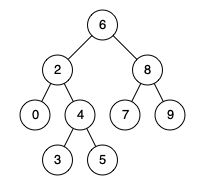二叉搜索树的最近公共祖先
235. 二叉搜索树的最近公共祖先
给定一个二叉搜索树, 找到该树中两个指定节点的最近公共祖先。
百度百科中最近公共祖先的定义为:“对于有根树 T 的两个结点 p、q,最近公共祖先表示为一个结点 x,满足 x 是 p、q 的祖先且 x 的深度尽可能大(一个节点也可以是它自己的祖先)。”
例如,给定如下二叉搜索树: root = [6,2,8,0,4,7,9,null,null,3,5]
示例 1:
输入: root = [6,2,8,0,4,7,9,null,null,3,5], p = 2, q = 8 输出: 6 解释: 节点2和节点8的最近公共祖先是6。
本题的解题思路:
已知搜索树的比父节点大的节点在右边,比父节点小的左边。
所以,当p,q两个节点的val都小于root节点的val的时候,就可以向左边遍历,反之右边也是一样。当p,q节点一个在左边,一个在右边的时候就找到了父节点。
这个题目类似二分查找。
非递归做法:
class Solution {
public TreeNode lowestCommonAncestor(TreeNode root, TreeNode p, TreeNode q) {
TreeNode ancestor = root;
while (true) {
if (p.val < ancestor.val && q.val < ancestor.val) {
ancestor = ancestor.left;
} else if (p.val > ancestor.val && q.val > ancestor.val) {
ancestor = ancestor.right;
} else {
break;
}
}
return ancestor;
}
}
递归做法:
/**
* Definition for a binary tree node.
* public class TreeNode {
* int val;
* TreeNode left;
* TreeNode right;
* TreeNode(int x) { val = x; }
* }
*/
class Solution {
TreeNode search(TreeNode root, TreeNode p, TreeNode q){
if(root == null )
return null;
if(root.val >= p.val && root.val <= q.val)
return root;
else if(root.val >= p.val && root.val >= q.val){ //节点都在左子树
return lowestCommonAncestor(root.left,p,q);
}
else
return lowestCommonAncestor(root.right,p,q);
}
public TreeNode lowestCommonAncestor(TreeNode root, TreeNode p, TreeNode q) {
if(p.val > q.val)
return search(root,q,p);
else return search(root,p,q);
}
}